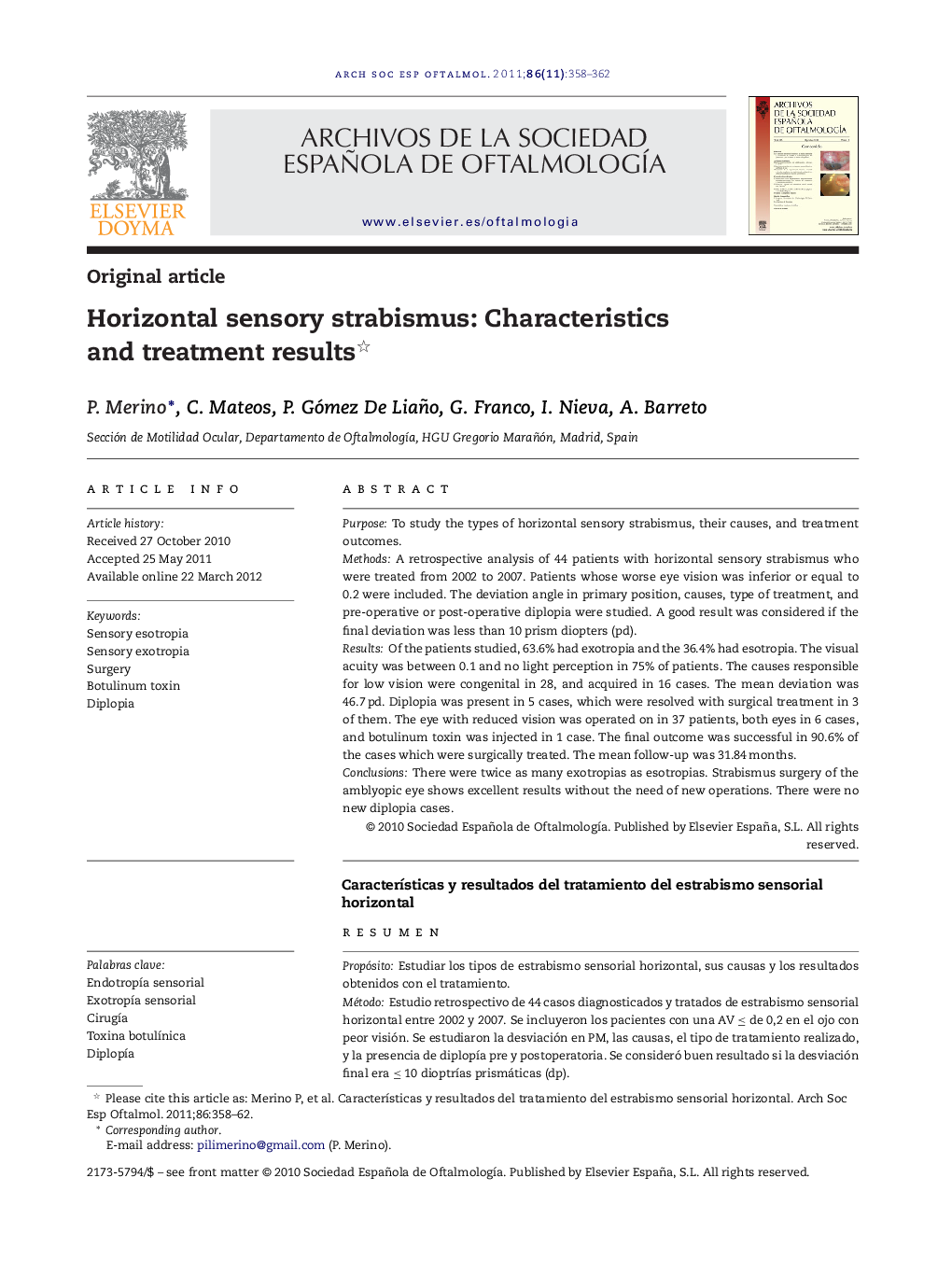| Article ID | Journal | Published Year | Pages | File Type |
|---|---|---|---|---|
| 4008575 | Archivos de la Sociedad Española de Oftalmología (English Edition) | 2011 | 5 Pages |
PurposeTo study the types of horizontal sensory strabismus, their causes, and treatment outcomes.MethodsA retrospective analysis of 44 patients with horizontal sensory strabismus who were treated from 2002 to 2007. Patients whose worse eye vision was inferior or equal to 0.2 were included. The deviation angle in primary position, causes, type of treatment, and pre-operative or post-operative diplopia were studied. A good result was considered if the final deviation was less than 10 prism diopters (pd).ResultsOf the patients studied, 63.6% had exotropia and the 36.4% had esotropia. The visual acuity was between 0.1 and no light perception in 75% of patients. The causes responsible for low vision were congenital in 28, and acquired in 16 cases. The mean deviation was 46.7 pd. Diplopia was present in 5 cases, which were resolved with surgical treatment in 3 of them. The eye with reduced vision was operated on in 37 patients, both eyes in 6 cases, and botulinum toxin was injected in 1 case. The final outcome was successful in 90.6% of the cases which were surgically treated. The mean follow-up was 31.84 months.ConclusionsThere were twice as many exotropias as esotropias. Strabismus surgery of the amblyopic eye shows excellent results without the need of new operations. There were no new diplopia cases.
ResumenPropósitoEstudiar los tipos de estrabismo sensorial horizontal, sus causas y los resultados obtenidos con el tratamiento.MétodoEstudio retrospectivo de 44 casos diagnosticados y tratados de estrabismo sensorial horizontal entre 2002 y 2007. Se incluyeron los pacientes con una AV ≤ de 0,2 en el ojo con peor visión. Se estudiaron la desviación en PM, las causas, el tipo de tratamiento realizado, y la presencia de diplopía pre y postoperatoria. Se consideró buen resultado si la desviación final era ≤ 10 dioptrías prismáticas (dp).ResultadosEn el 63,6% de los casos se diagnosticó una exotropía (XT) y en el 36,4% una endotropía (ET). El 75% de los pacientes tenía una AV entre 0,1 y NPL. Las causas fueron congénitas en 28 y adquiridas en 16 casos. La desviación media fue de 46,7 dp. En 5 casos había diplopía que se resolvió en 3 con el tratamiento. No hubo nuevos casos de diplopía postoperatoria. La cirugía se realizó solo en el ojo ambliope en 37 pacientes, en 6 en AO, y en 1 se inyectó toxina botulínica. El resultado quirúrgico fue bueno en el 90,6%. El tiempo de evolución fue de 31,84 meses.ConclusionesLas XT han sido casi el doble que las ET. La cirugía ha conseguido muy buenos resultados, con un mínimo de reintervenciones, operando solo el ojo ambliope. No hubo diplopías postoperatorias.
